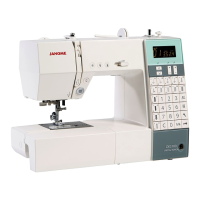45
Applique
q Stitch pattern: 31−37
w Thread tension dial: 1 to 4
e Presser foot: Satin stitch foot F
r Presser foot pressure dial: 3
Place an applique on the fabric and baste or pin it in
place.
Reduce the foot pressure to 3 (refer to page 8).
Lower the needle at the outer edge of the applique.
Sew while guiding the fabric so the needle falls along the
outer edge of the applique.
q Applique
w Outer edge
When turning a sharp corner, stop the machine with the
needle at the outer edge of the applique.
Raise the foot and pivot the fabric around the needle to
change the sewing direction.
•Adjustingthestitchwidth
Select pattern 31.
Press the stitch width adjusting key to change the stitch
width.
Press “–” to decrease the stitch width r.
Press “+” to increase the stitch width t.
The stitch width will be varied based on the centered
needle drop position y.
(A) The stitch pattern 37 has a fixed left needle drop
position. When you change the stitch width, the right
needle drop position will change.
(B) The stitch patterns 31, 32 and 33 have a fixed
center needle drop position. The stitch width changes
symmetrically.
(C) The stitch patterns 34, 35 and 36 have a fixed right
needle drop position. When you change the stitch width,
the left needle drop position will change.
Shelltuck
q Stitch pattern: 25
w Thread tension dial: 6 to 8
e Presser foot: Satin stitch foot F
Use a lightweight fabric (tricot, for example).
Fold the fabric in bias as shown and stitch on the fold.
Allow the needle to barely clear the folded edge to create
a shelled edge.
q Needle
w Fold
If you sew rows of shell tuck, space the rows at least
1.5 cm (5/8˝) apart.
You can also sew shell tuck on knits or soft silky woven
fabrics, in any direction.
q
w
e
q
w
q
w
e
q
w
(A) (B) (C)
r
t
y
r
DECORATIVESTITCHING

